




Key Takeaways
- SL students need targeted strategies beyond standard ACT prep methods.
- Strong grammar skills can give non-native speakers an edge in ACT English.
- Time management and cultural context are key to overcoming ACT reading challenges.
ACT prep for non-native English speakers presents unique challenges that many international students discover when they start preparations. Most ESL students encounter two key realizations: first, they need specialized strategies beyond standard test prep, and, second, English language skills impact performance across all ACT sections, not just English and Reading.
Since U.S. colleges conduct all coursework in English, the ACT naturally evaluates every student’s English proficiency throughout the entire exam. This creates additional complexity for international students, given that 9 out of the top 10 countries sending the most students to the U.S. don’t have English as their first language.
The good news is that high ACT scores are certainly achievable for non-native English speakers with targeted preparation strategies and the right guidance.
This comprehensive guide covers essential ACT English prep for ESL students, plus actionable tips for maximizing scores in Math and Science sections where language barriers can be minimized.
Key challenges that non-native English speakers face
ACT preparation for ESL students involves overcoming several language-specific obstacles that can significantly impact test performance. Understanding these challenges is the first step toward developing effective strategies.
- Slower reading speed under time pressure: Non-native speakers typically read slower than native speakers, creating serious time management issues across all ACT sections, especially Reading and Science.
- Complex vocabulary, idiomatic expressions, and informal language: The ACT frequently uses idioms, colloquialisms, and context-dependent phrases that don't translate directly. Expressions like "piece of cake" or "break the ice" can confuse students who learned English through formal instruction.
- American cultural references: Reading passages often include cultural references unfamiliar to international students, such as sports terminology (“curve ball” or “home run”), pop culture references (characters like Thor or Jedi, historical events), or cultural traditions (Thanksgiving, prom).
- Ambiguous question phrasing: ACT reading strategies for ESL students must address how question wording can create confusion. Phrases like "which of the following best suggests" or "the author would most likely agree" require nuanced English comprehension.
- Limited ESL-friendly prep materials: Most ACT English prep for ESL students relies on materials designed for native speakers, leaving international students without culturally relevant examples or bilingual explanations.
- Lower confidence in language-heavy sections: The factors mentioned previously, in combination, often create anxiety specifically around English and Reading sections, leading to rushed decisions and second-guessing correct answers.
ACT English section: ESL tips and resources
The encouraging reality about ACT English prep for ESL students is that targeted strategies can transform language challenges into competitive advantages. Non-native speakers often develop stronger grammatical foundations than native speakers, creating unique opportunities for high scores.
- Build ACT-relevant vocabulary: The ACT tests a predictable set of high-frequency words. Focus on academic vocabulary lists specifically designed for standardized tests rather than general English dictionaries. Reliable resources like Barron’s wordlist have a set of words that the ACT is most likely to test students on.
- Read American academic writing: ACT reading strategies for ESL students should include regular exposure to the four passage types: prose fiction, social studies, humanities, and natural sciences. They should read articles from sources like National Geographic, The Atlantic, and academic journals to familiarize yourself with American writing styles and sentence structures.
- Use bilingual resources with caution: While bilingual practice resources are great for easier understanding and grasping, students should remember that the actual ACT offers no such facility. Hence, as their prep journey advances, they need to reduce their reliance on bilingual resources. This progressive approach builds confidence while ensuring they're prepared for the monolingual test environment.
- Practice with ACT-level grammar: The ACT English section tests a limited set of grammar concepts repeatedly. Students should focus on punctuation rules, subject-verb agreement, modifier placement, and parallel structure rather than trying to master every grammar rule in English.
- Leverage your ESL advantage: Students who have studied English as a second language, paradoxically, enjoy a slight advantage over native speakers. Formal language instruction creates stronger awareness of rules. Native speakers frequently make careless errors with homophones (their/there/they're) or contractions (its/it's) that ESL students avoid through careful analysis.
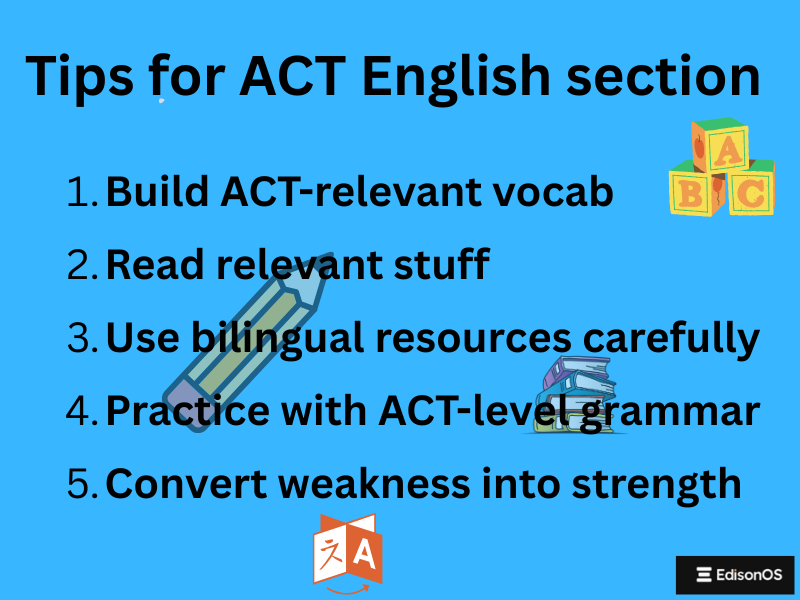
ACT Reading Section: Overcoming language barriers
ACT reading strategies for ESL students must address the shift from memorization-based learning to critical analysis. Many international students excel at factual recall but need additional practice with inference and interpretation questions that dominate the ACT Reading section.
Here are five tips that will help your students overcome language barriers and do well in the Reading Section of the ACT.
- Master strategic reading techniques: Don't read every word. Effective ACT prep for non-native English speakers emphasizes skimming for main ideas first, then diving into details when answering specific questions. Often, but not always, the opening and closing paragraphs will help identify the central idea of the passage as well as the author’s stand.
- Practice active reading: Summarize each paragraph mentally as you read. This technique helps ESL students map passage structure, track argument development, and locate answers more efficiently during the 35-minute time limit.
- Learn to break down question types: Understanding ACT Reading question patterns builds confidence and speeds comprehension:
- Direct/detail questions: Find specific information in the passage
- Inference questions: Draw conclusions from given information
- Main idea questions: Identify the passage's central theme
- Author's viewpoint questions: Determine the writer's stance or tone
- Vocabulary-in-context questions: Define words based on surrounding text.
- Identify the central idea: Each passage will have a certain central idea. ESL students preparing for the ACT should practice identifying this central idea within the first two minutes of reading, as it anchors correct answers across multiple questions.
- Spot recurring mistakes: Systematic mistake analysis accelerates improvement. Record which question types cause difficulty, whether timing issues stem from vocabulary or comprehension, and which passage types (fiction vs. science) need additional focus.
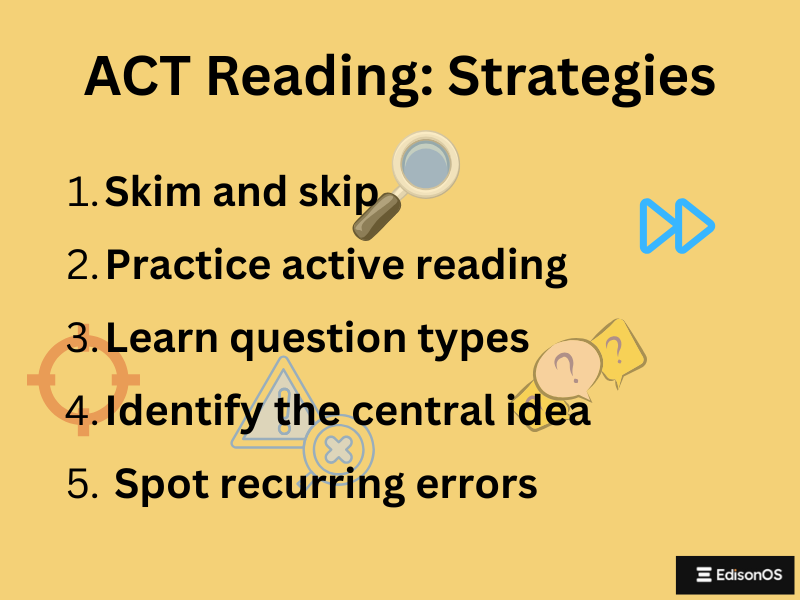
ACT Math and Science: Leverage strengths
While Math and Science sections seem less language-dependent, ACT prep for non-native English speakers must address how English comprehension impacts performance across all four sections. Understanding these language elements helps ESL students maximize their strongest areas.
- Navigate precise Mathematical language: ACT Math uses extremely concise wording where every word matters. Key terms like "at least," "at most," "closest to," and "approximately" have specific mathematical meanings that differ from everyday usage. ESL students preparing for the ACT should create glossaries of mathematical terminology to avoid misinterpretation that leads to wrong answers despite correct calculations
- Visuals and translations: Math questions where language has no role to play (for instance, questions dealing with powers and exponents) is where students can leverage their strengths. Also, during the prep, the ACT tutor can use visuals and translations to bolster their student’s performance.
- Master Science passage structure: ACT Science tests data interpretation more than scientific knowledge. Non-native English speakers can succeed by learning to quickly identify chart titles, axis labels, and trend descriptions rather than reading every word of experimental descriptions. Practice extracting information from graphs, tables, and diagrams where language barriers are minimal.
On the whole, students should be fully conversant with the format of the digital ACT and thus understand the significance of language skills for these two sections.
Time management tips for ESL students
Effective time management separates successful ACT prep for non-native English speakers from average performance. Since ESL students typically need more processing time for English text, strategic timing approaches become essential for competitive scores.
Here are the four most important time management tips for ACT to teach your students:
- Build reading speed under time pressure: Practice reading comprehension with strict time limits to develop the mental stamina needed for test day. ACT reading strategies for ESL students should include daily 15-minute timed reading sessions using actual ACT passages to build both speed and accuracy simultaneously.
- Question-first strategy for the Reading section: Read questions before passages to create a mental roadmap of what information to seek. This approach helps ESL students preparing for the ACT focus on relevant details while skimming efficiently past less important descriptive text, maximizing comprehension within time constraints.
- Run timed drills: Some tutors run drills for individual passages, while others time for the entire section. Start with individual passage timing (8-9 minutes per passage) before attempting full 35-minute Reading sections. This progressive approach builds confidence while identifying which passage types require additional time allocation. The Science section should follow similar patterns with 5-6 minutes per passage.
- Master strategic guessing techniques: When questions become time-consuming, make educated guesses and continue forward momentum. Non-native English speakers often overthink answer choices due to language uncertainty. But don’t let that hold back the student’s pace. Train them to make the best guess and move to the next question.
Optimize section-specific timing
- English: 45 minutes for 75 questions (36 seconds per question)
- Reading: 35 minutes for 40 questions (52 seconds per question)
- Math: 60 minutes for 60 questions (1 minute per question)
- Science: 35 minutes for 40 questions (52 seconds per question)
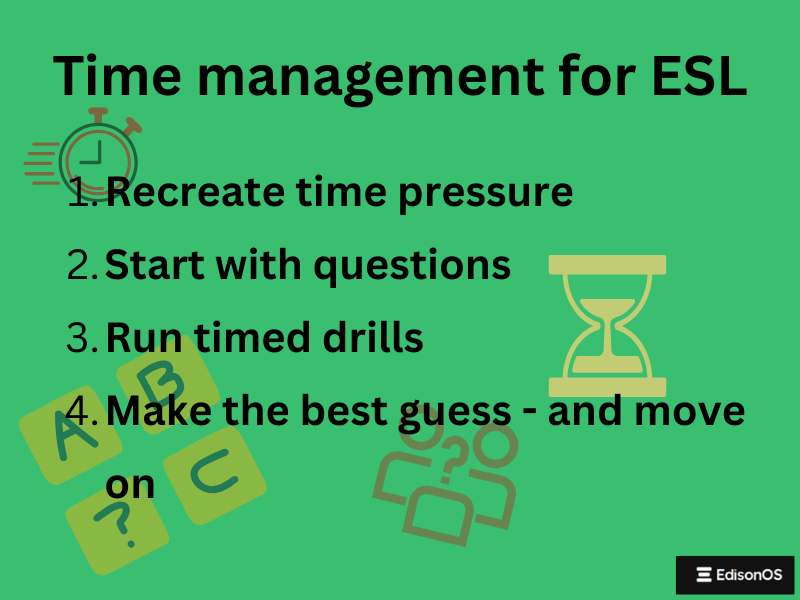
Finding the right prep support and materials
Success in ACT English prep for ESL students depends heavily on choosing resources specifically designed for non-native speakers' unique learning needs. The right combination of personalized tutoring, multilingual tools, and targeted materials accelerates progress significantly.
- Personalized diagnostic assessment: Effective ACT prep for non-native English speakers begins with comprehensive diagnostic testing that identifies specific language gaps alongside content knowledge. Qualified tutors should evaluate reading speed, vocabulary level, grammar understanding, and cultural knowledge deficits to create customized study plans addressing individual weaknesses.
- Multilingual learning tools: Digital tools that enhance learning over multiple languages are vital for non-native English speakers. Begin with bilingual dictionaries and translated explanations for complex concepts, then gradually transition to English-only resources. Advanced ESL students should exclusively use English-English dictionaries 6-8 weeks before test day to simulate actual testing conditions.
- Essential ACT prep books and apps: Depending upon what the diagnostic test shows, there will be a variety of books and apps to choose from. Commonly recommended books include The Official ACT guide, Barron’s guide to the ACT, Kaplan’s ACT books, and Princeton Review books among others.
How tutors can help ESL students with ACT prep
Effective tutoring for non-native English speakers preparing for the ACT requires a systematic, data-driven approach that addresses unique language learning needs while building toward test independence.
The best way tutors can help students is to follow a simple model like this:
- Create data-driven personalized study plans.
- Use performance analytics for targeted improvement
- Provide strategic bilingual support
Use Edison’s mock ACTs to accurately assess the student’s proficiency. These tests are created by ACT experts and match the actual ACT as closely as possible.
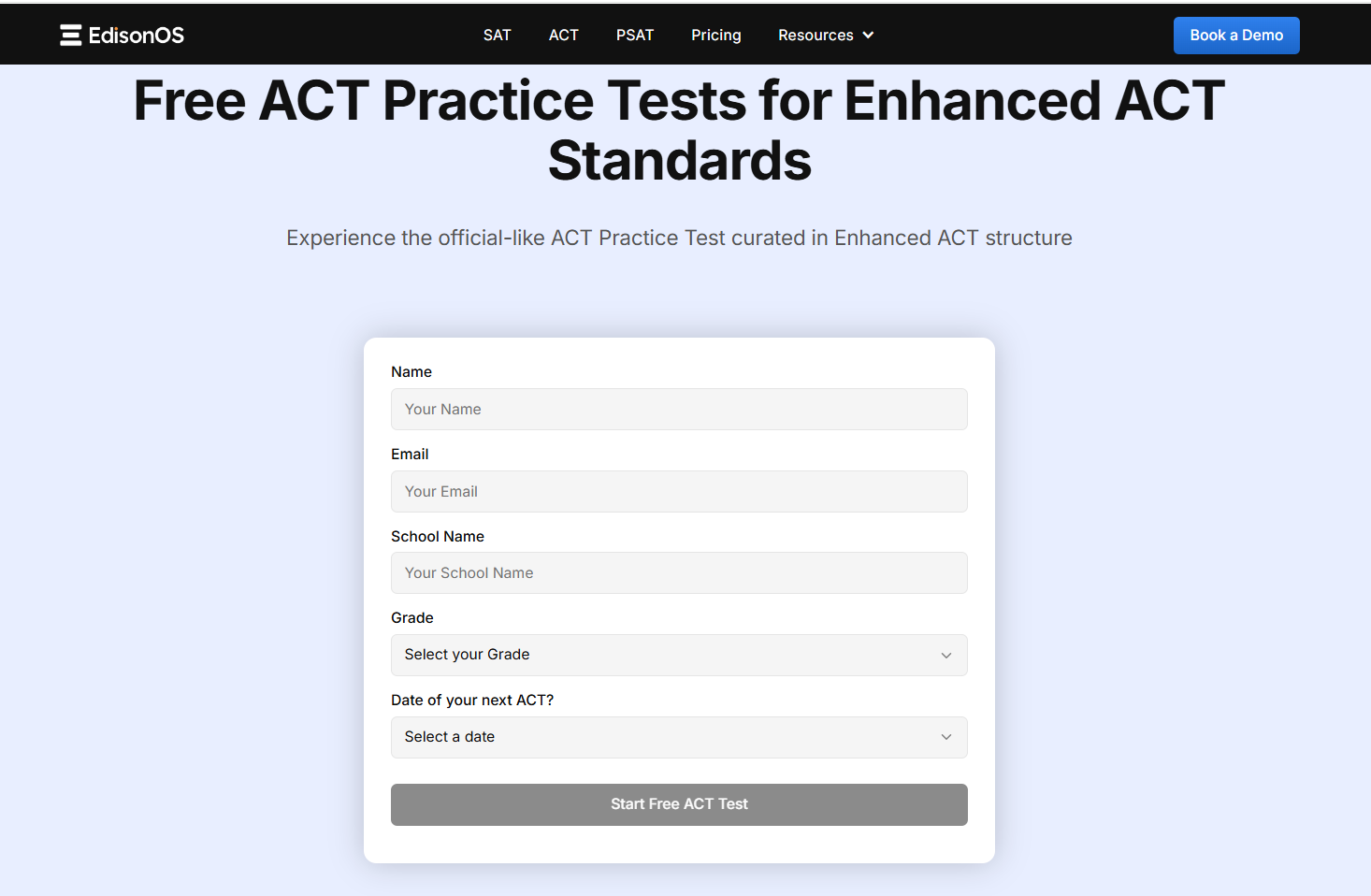
These expert-designed practice tests reveal specific performance gaps across all four sections.
Strategic planning elements:
- Allocate 60% of study time to English and Reading sections where language barriers create the greatest challenges
- Set realistic score improvement targets based on current proficiency and college admission requirements
- Build study schedules accommodating slower processing speeds typical for ESL students preparing for the ACT.
Next, use data. Efforts towards ACT prep for non-native English speakers would produce limited results at best without measurable progress tracking.
Key data points to monitor:
- Error pattern analysis across question types (inference vs. detail questions)
- Time allocation efficiency for each passage type
- Vocabulary gap identification in high-frequency ACT terms
- Grammar rule mastery progression over time
Lastly, offer feedback and actionable tips using their ESL-specific progress.
Effective feedback strategies:
- Explain complex grammar rules in native language initially, with English reinforcement.
- Provide cultural context for American references using bilingual examples.
- Use reading strategies that gradually reduce translation dependency.
- Monitor progress and eliminate bilingual support 4-6 weeks before test date.
Mastering the ACT as a non-native speaker
ACT prep for non-native English speakers presents both unique challenges and distinct opportunities. From mastering ACT-specific grammar and vocabulary to decoding culturally rooted passages, students can make remarkable progress with the right guidance. Skimming techniques, active reading, bilingual resources, and time management strategies further sharpen their test readiness.
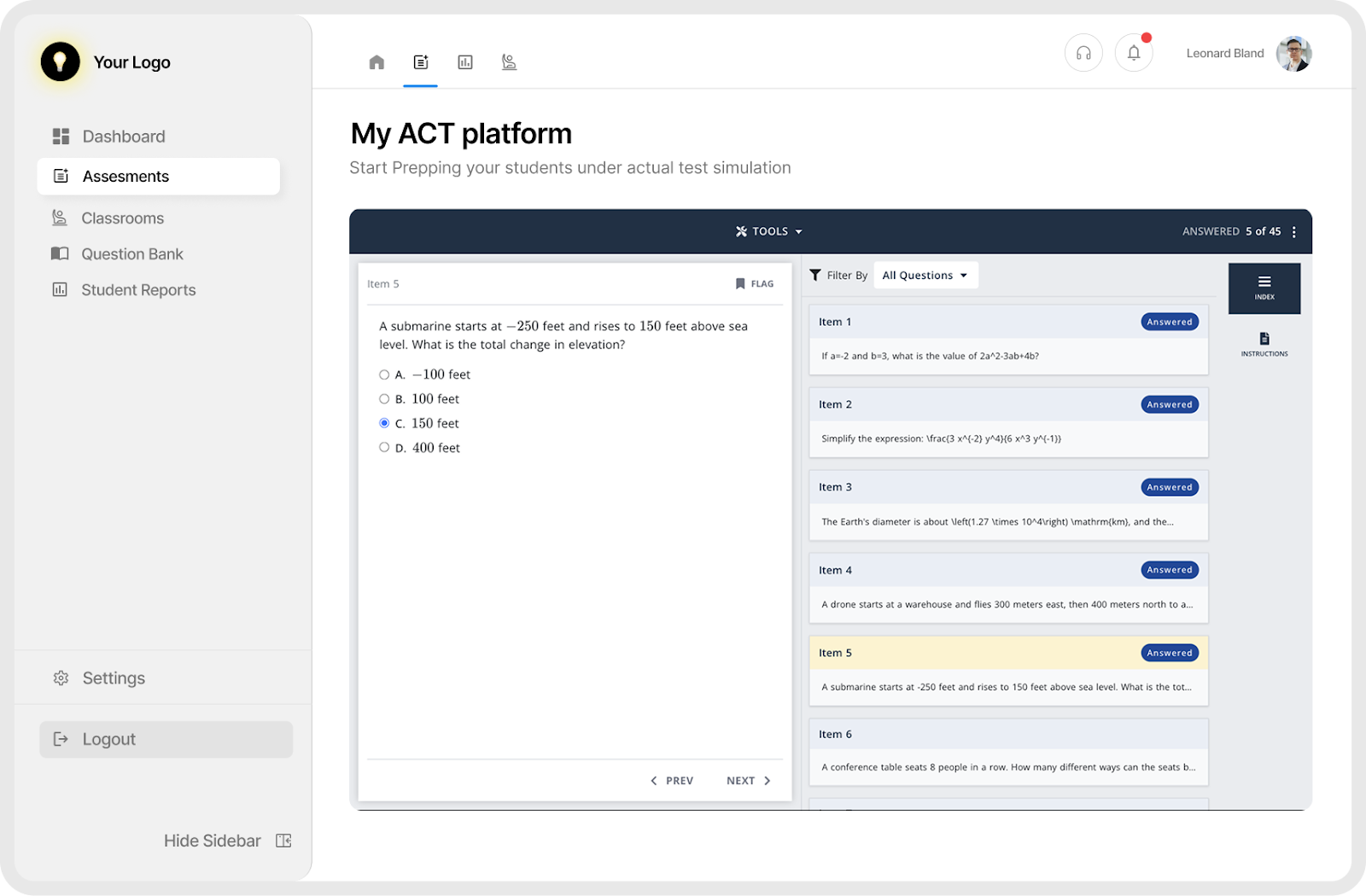
But more than any single strategy, it’s consistent practice, paired with the right tools, that makes the real difference.
EdisonOS empowers tutors to deliver truly personalized ACT English prep for ESL students through:
- Custom ACT prep journeys with interactive tools designed for ESL learners
- Performance tracking that identifies student-specific problem areas and improvement trends
- Targeted practice assignments including extra reading comprehension tasks and vocabulary sets
- Progress reporting that can be shared with parents to support student success
If you’re a tutor looking to make ACT prep more focused, effective, and ESL-friendly, connect with an Edison expert today.
Frequently asked questions

Tutors Edge by EdisonOS
in our newsletter, curated to help tutors stay ahead!
Tutors Edge by EdisonOS
Get Exclusive test insights and updates in our newsletter, curated to help tutors stay ahead!
Recommended Reads
Recommended Podcasts






.png)




.png)
.webp)
